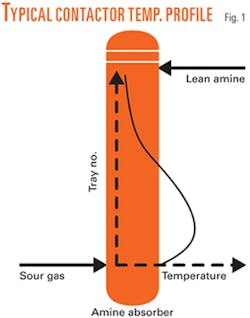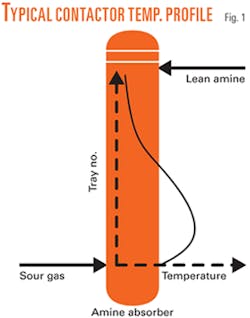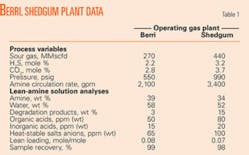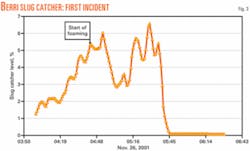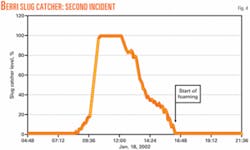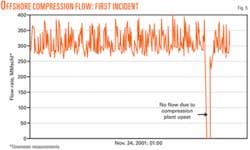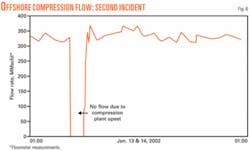Investigation and troubleshooting of foaming in two Saudi Aramco amine sweetening facilities reduced reliance on continuous antifoam injection at the company’s Berri gas plant by identifying the source of the problem. At the Shedgum gas plant, however, economics dictated continuing antifoam injection.
Both case studies revealed that liquid hydrocarbon carryover with sour feed gas was the main foam promoter. A lesson learned from these two cases was to focus on defining the foaming problem. This allowed a better understanding of the problems and provided the least expensive solution to abate foaming or reduce its severity.
Diglycolamine (DGA) is the most widely used amine-sweetening agent in Saudi Aramco’s plants. As with other amines such as monoethanolamine (MEA), diethanolamine (DEA), and methyl diethanolamine (MDEA), foaming is a major concern especially in high-pressure systems.
This article will demonstrate the benefits of proper troubleshooting to identify sources of amine foaming in the two Aramco gas plants. It will also provide some general information about amine foaming, causes, symptoms, and troubleshooting guidelines.
Foaming
Amine-solvent foaming has been widely discussed in the gas processing industry and in the literature. Foaming continues to occur in amine facilities because various factors induce foaming and a lack of operational knowledge exists for troubleshooting foaming incidents.
Many operational practices regarding foaming problems try to solve what caused such incidents rather than develop a strategy to track the sources of foaming and alleviate them or reduce their impact. High capital losses occur annually due to foaming in amine systems. Such losses derive from the temporary loss of sour-gas processing capability and hence a reduction in sales and fuel-gas production, solvent loss, and violation of environmental regulations.
Foaming in any Saudi Aramco treating plant generates serious revenue loss due to the huge size of the gas-sweetening units that treat about 7 bscfd of sour gas using DGA. Continuous antifoam injection has been the most common method to suppress foaming. Although use of antifoam injection is well known and documented, it is only recommended as a last resort and then only intermittently.
Because most of antifoams are surface active, high dosage could aggravate foaming problems. Besides, some recent findings suggest that antifoam reduces the absorption capacity of CO2 by 40-55%. Those findings, however, were based on use of MDEA.1
To reduce reliance on antifoams and increase operational confidence in high-pressure amine systems, the central engineering group of Saudi Aramco, working with field and operation engineering in two gas plants, decided to focus on identifying the sources of foam and eliminate them rather than trying to suppress the foam.
Foaming in amine systems
Pauley defines foaming as “a result of a mechanical incorporation of a gas into a liquid, where the liquid film surrounds a volume of gas creating a bubble.”2 Two key characteristics are needed to present a foaming concern:
- Solution tendency to foam-the ease with which a solution forms a foam bubble.
- Foam stability-foam resistance to break into continuous liquid phase. The higher the foam tendency and stability, the higher the possibility of a foaming problem.
Surface tension is the primary indication of foaming tendency. Lower surface tension leads to more solution susceptibility to foam. The major source of reduced surface tension of an amine solution is solution contamination with surface-active agents, which include liquid hydrocarbons.
Surface tension is also affected by operating conditions; higher temperature and pressure tend to reduce surface tension. Temperature has the upper hand in impacting surface tension of an aqueous amine solution.
Higher pressure, to a lesser extent, affects solution-foaming tendency. At higher pressures, the solubility of liquid hydrocarbons in the amine solution increases, thereby changing the surface structure of the aqueous solution and rendering a lower surface tension and hence increased system tendency to foam.3
That is exactly what has been observed in Saudi Aramco’s gas processing facilities where most of the current foaming concerns are in the amine plants that are operating at high pressures. Having a low surface tension does not indicate a stable foam and hence a foaming problem.
Stability, related to the nature of the surface layer, is the other key factor of having a foaming concern. Foam stability depends on three characteristics: elasticity, gelatinous layer formation, and film drainage.4
- Having higher elasticity, and therefore resistance to thinning, generates lower foaming stability. The major function of most antifoam is to increase the solution elasticity and hence reduce the foam stability.
- Gelatinous or plastic layer is a surface structure related to the nature of molecular composition of the aqueous solution; solutions that are prone to form gelatinous layers tend to have higher foaming stability.4 Secondary (DEA) and tertiary (MDEA) amines form this layer more easily than primary (MEA and DGA) amines. They are, therefore, more susceptible to foam. Contaminants, such as amine degradation products, induce the formation of the gelatinous layer.
- Faster film drainage reduces foam stability. Fine particulates, however, such as iron sulfide, tend to retard film drainage and hence increase foam stability.
Foam inducers
Clean uncontaminated amine does not form stable foam. Amine system foaming results from contaminants either introduced to the system through the feed gas, make up water, and recycled streams or generated in the system, such as degradation and corrosion products. Here are the most common causes of foaming:5-8
1. Liquid hydrocarbon introduced by sour feed gas is the primary cause of foaming problems in gas-sweetening plants. Liquids can be introduced as mist entrainment or carryover or can be formed inside the column if the lean amine entering the column is cooler than the sour-gas dewpoint.
The impact of liquid hydrocarbon comes from its solubility in the aqueous amine solution, which therefore reduces its surface tension. Secondary and tertiary amines, more than primary amines, tend to foam in the presence of liquid hydrocarbons due to the higher solubility of liquid hydrocarbon in secondary and tertiary amines.
One of the tasks is the removal of liquid hydrocarbon droplets of aerosol size. Droplet sizes greater than 3μ are generally controllable; smaller sizes require careful filter-separator and coalescer design. Some plants were able to reduce the liquid carryover by installing 0.3μ coalescers upstream of the amine absorber columns.9
2. Solid particulate contamination, especially iron sulfide, is one of the major causes of foaming. Iron sulfides, as very fine particulates, are difficult to remove by conventional mechanical filters, tend to concentrate in liquid-gas interface, and hence increase foaming stability. Iron sulfide, a by-product of corrosion activities of hydrogen sulfide and carbon steel piping, could be carried over from the sour feed gas or generated in the amine solution due to such reasons as high solution acid-gas loading, high velocities, and formation of acidic degradation products.
3. Water-soluble surfactants such as corrosion inhibitors, well-treating compounds, and excessive antifoam agent tend to dissolve in aqueous solutions and reduce surface tension. Such contaminants are often much more problematic than liquid hydrocarbons, if an appreciable amount exists in the sour gas, due to their higher solubility in amine solution.
4. Amine degradation products lead to changes in the amine solution’s structure and may increase the foaming tendency. Degradation products are compounds formed either by direct reaction of the amine and constituents in the feed gas (such as CO2, COS, CO, O2, and CS2) or by thermal decomposition of the amine. Conversion of the amine, irrespective of the mechanism, represents a loss of active and valuable amine.
5. Heat-stable salts not only tend to reduce the system’s sweetening capability, but also increase the amine solution’s corrosivity. Corrosion products, mainly iron sulfide, and changes in solution physical properties tend to increase the foaming stability and tendency, respectively.
Because heat-stable salts are not thermally regenerable, they accumulate in and contaminate the circulating amine solution. Such heavy salts are products of amine reaction with other anionic species or stronger acidic components (other than H2S and CO2) present in the sour feed gas.
6. Oxygen ingress in the feed or amine solution, even at parts-per-million levels, leads to the formation of carboxylic acids that react with amine to form heat-stable salts and hence increases the system’s tendency to foam. Positive pressure is always required to avoid any accidental oxygen leakage to the system. One area that needs to be monitored is the amine storage tank that should normally be protected by an inert-gas blanket, usually of nitrogen.
7. Makeup water could be another source of introducing various contaminants to the system. The main source of the makeup water is the utility plant where various chemical additives are introduced to treat it before it is fed to the steam boilers. Such chemicals include corrosion inhibitors and boiler-feed-water chemicals. Demineralized water could provide a very safe source of makeup.
Foaming symptoms
An amine system subjected to foaming exhibits the following behavior:
- Sudden increase in the column’s differential pressure is the first alarming sign of a foaming system. Normally, amine absorber columns come equipped with differential pressure cells to monitor system abnormalities. When the contactor faces foaming and as the foam height increases, the void volume inside the column is reduced, which leads to higher pressure drop.
- Off-specification sweet gas results from the loss of some absorption capacity of amine solution. Foaming reduces the vapor-liquid contact area, generating a reduced effective mass-transfer zone and hence less acid gas is picked up by the amine.
Most of the gas processing plants are equipment with an online analyzer to detect H2S concentration in the sweet gas to avoid producing an off-specification sales or fuel gas. Unexpectedly high H2S content in the sweet gas indicates possible foaming. - Amine carryover to downstream equipment is a late warning of foaming in the column and could be indicated by erratic or abnormal levels in the downstream knockout drums.
- Loss or reduction in the rich-amine flow rate is accompanied by an erratic or abnormal level indication in the absorber column’s bottom section.
- Abnormal absorber column’s temperature profile can be another indicator. A typical temperature profile has a shape of a pregnant woman; the bulge (maximum) temperature is in the lower trays where the main reaction between acid gas and amine solution occurs (Fig. 1). During foaming, the bulge temperature normally shifts from the lower trays to the upper trays, especially if foaming was caused by contaminated sour gas.
Antifoam injection
Antifoam does not eliminate foaming; rather, it reduces its severity. Most antifoams tend to increase the surface layer’s elasticity, allowing it to resist film thinning.7 Once antifoam injection ceases, the system becomes vulnerable to foaming at any time because the foam-inducing contaminants are still in the system. Relying solely on antifoam to avoid foaming allows to contaminants to build up in the system. This buildup leads to such other serious problems as amine degradation, solvent losses, and corrosion.
Excessive antifoam dosing reverses its function and makes it a foam promoter. This phenomenon has been clearly demonstrated by Saudi Aramco Research & Development Center, which found that silicon based antifoam increases its foam-reducing power in a DGA system up to a concentration of 25 ppm; nothing was gained beyond that. At 9,000 ppm, antifoam begins to stabilize the foam and therefore increases the foaming severity.10
Another side effect that has yet to be fully proven for the primary amines is the impact of antifoam on the reduction of the mass transfer rate. One study concluded that the presence of antifoam renders lower diffusion of the acid gases into the amine solution, hence reducing amine-absorption capacity.1
Because of these reasons and the extra cost associated with antifoam chemicals, antifoam should be the last option. Consequently, preventing contaminants and maintaining a good quality amine should be the primary target.
Case studies
Foaming in high pressure gas-treatment facilities at Saudi Aramco has been a concern since their start-up. Currently there are seven high-pressure treatment trains in Saudi Aramco that are using DGA as the sweetening solvent: Five are processing nonassociated sour gas in the southern area and two at the Berri gas plant treat high-pressure offshore associated gas.
Continuous antifoam is being extensively used in the southern plants. In the Berri plant, antifoam injection underwent various changes from batch injection to continuous injection as a reaction to some foaming incidents in which the plant management could tolerate no further reduction in gas supply. Central engineering group decided to tackle the foaming problem in two locations where there have been elevated concerns regarding foaming.
The main target of the troubleshooting was to identify the source of foaming rather than relying on the practice of optimizing the antifoam injection rate. Listed below are the two case studies with some background on the plants, causes of the problems, and recommendations to abate foaming or reduce its severity.
Shedgum-history
Foaming in the high-pressure amine contactor has been a problem since start-up of the plant. Sour nonassociated Khuff gas was first introduced to the unit in 1991 with the amine being regenerated in one of the low-pressure gas treatment plants. Maximum throughput attained at that time was 280 MMscfd. (Design rate is 440 MMscfd.) Even at that rate, the system did not stabilize due to the onset of early foaming symptoms.
The commissioning tests indicated that foaming in the HP contactor was caused by some contaminants in the amine system. Therefore, activated-carbon beds were installed temporarily to remove dissolved hydrocarbons.
After applying three batches of activated carbon, which were exhausted within 35 days, the plant was only capable of processing 250 MMscfd of sour gas. No more activated carbon was added and the system was dismantled for economic reasons.
With the continuous antifoam injection of 0.72 ppm (vol), the train was able to process a maximum sustainable sour-gas rate of 460 MMscfd.
Since then, the plant has been using continuous antifoam. With time, its processing capacity has declined and symptoms of foaming have occurred when the plant has been operating around the design rate even with continuous antifoam injection.
Table 1 shows the basic information about the HP unit.
The team formed to resolve the problem focused on three major areas. Two of them address potential causes of foaming; the third explores possible options to reduce the foaming. The areas are:
- Amine solvent quality.
- Sour feed-gas pretreatment.
- Areas of improvements.
Amine solvent quality
Amine solution quality is crucial in predicting and preventing foaming. The first step taken was to check the lean-amine solution’s quality. Analyses showed a detailed breakdown of the solution’s constituents but did not show the content of either the dissolved hydrocarbon or dissolved solids, which were expected to be the major cause of foaming in the plant.
The results revealed 15 wt % degradation products in the solution. The conventional titration method was showing an amine concentration of around 40-50 wt % before the detailed analysis. It was found, however, to be <34 wt %. Table 1 shows the complete analyses results.
This is a clear sign that there is a poor amine quality circulating in the system. The main reason was the system’s configuration at that time when a common regenerator was used for the HP and LP trains. Investigators speculated that hydrocarbons were in an appreciable amount due to the amine filtration system that does not contain activated-carbon beds.
Existing filtration consists of precoat filter (1μ rating) and a mechanical cotton-fiber filter (5μ rating) designed to process 10% of the circulating amine solution. Earlier studies showed that when activated-carbon beds were installed, they were exhausted in less than 35 days. This indicated that amine was severely contaminated with dissolved hydrocarbon introduced by the sour feed gas.
Sour-gas pretreatment
The HP unit is equipped with a slug catcher for removing bulk liquids and two vertical three-phase filter-separators for removing liquid aerosols and solid particulates with diameters of >0.5μ.
The filters were equipped with two separate compartments, 42 filter-coalescing elements, and vane pack. Estimated clean pressure drop (criterion for replacing the filter element) across the filter separator was 1.25 psi. A high pressure drop has never been a concern in the plant since the unit start-up.
We concluded that the presence of solids in the gas phase was not a major concern and, therefore, decided to inspect the filter separator for mechanical damage to the filter elements. Most of the filter elements were found to be in good mechanical condition except for three elements that had some cracks that could have been caused by improper installation or damage during the removal process.
Another important issue we looked at was to verify the liquid loading inside the filter separator. To do that we collected samples from locations No. 1 and No. 2 (Fig. 2).
We used samples from No. 2 as simulation input and analyzed samples from No. 1 for liquid loading to confirm the simulation results. In No. 1, we collected samples from the vertical segment of the pipeline to have a representative sample. The collection point was carefully chosen to be as close as possible to the exit nozzle of the heat exchanger to minimize liquid settling.
We use No. 2 to collect gas stream samples where the possibility of having liquid is minimal. We used the results of an analysis of this stream in the simulation to estimate the liquid formation downstream of the heat exchanger. A combination of both methods provided a good representation of the liquid loading.
Simulated cases showed a liquid loading of 320 gpm, while the design rate for each filter-separator was 62 gpm. Liquid loading measured from No. 1 showed variations from as low as 15 gpm to as high as 320 gpm. This indicated that the filter-separators were well under-designed for handling the high liquid loadings due mainly to the plant being operated under an inlet-gas composition that differs from the design.
Areas of improvement
It was clear that high liquid loading that exceeds the design of the exiting filter-separator is the main cause of foaming in the plant. Nonetheless, the high capital cost of installing additional filter-separators and of the commissioning of a new regeneration system for the HP unit led to the decision to continue using continuous antifoam injection as the primary option to suppress foaming.
Several low-cost modifications and operational practices were adapted to improve the unit performance and reduce the foaming severity, including:
- Retrofitted perforated liquid surface-protection plate above the maximum liquid level. This will reduce agitation activities at the liquid surface and hence the liquid carryover rate.
- Modified the level-control system to have one controller for both liquid hydrocarbon and water levels. This will allow faster drainage of the liquid and reduce carryover.
- Enhanced operational awareness of some of the important practices, such as routine skimming of hydrocarbon liquids from the flash and the reflux drums, eliminating the oxygen ingress to the amine storage facilities, and operating the flash drum at pressures as low as possible to flash more hydrocarbons.
Berri gas plant-background
Treatment of an offshore high-pressure sour gas at two amine treating units at the Berri gas plant was commissioned in 1998 and 2000, respectively (Table 1). Since their start-up, the units were hit by a series of foaming incidents during the winter season. During each incident, the plant used batch antifoam to control the problem. Some recent incidents, however, have led to continuous antifoam injection being practiced.
The two high-pressure trains use activated-carbon beds to treat the amine solution with upstream and downstream guard filters. Being surface active, the activated-carbon beds absorb the antifoam and hence are exhausted quickly.
It was a common practice to have the beds offline during antifoam injection. Having them offline leads to the dilemma of not having a sink source for the antifoam. Continuous antifoam injection means continuous buildup of the antifoam agent in the system that could after time reverse the functionality of antifoam.
Continuous antifoam at Berri has a more severe impact on the system than at Shedgum. That plant is equipped with a precoat filter that acts as a sink for the antifoam agent.
Our laboratory found that silicon-based antifoam (100 ppm) was completely removed from the amine solution by one pass through 1-in. precoat filter media. The lab estimated that the precoat filter at the plant removed 70% of the antifoam.10
Therefore, identifying the causes of foaming was imperative to convince plant management to stop practicing continuous antifoam injection. Answering a series of questions will review the two recent foaming incidents, foaming in the HP system, its causes and recommended remedies:
• What went wrong in the Berri gas plant’s HP amine unit?
The main cause of the foaming incidents was liquid carryover with the sour-gas stream mainly as a result of liquid condensation in the pipeline after an upset in the offshore gas producing facilities.
The upstream facilities use a refrigeration system to control the hydrocarbon dewpoint at about 60° F. to condense heavy hydrocarbons and hence avoid their condensation along the pipeline.
Immediately preceding the last two foaming incidents, the upstream gas compression plant and the refrigeration systems were shutdown temporarily. This upset resulted in hydrocarbon condensation and liquid buildup in the pipeline that was carried to the Berri slug catcher. Inadequate drainage of the slug catcher’s liquid level caused liquid carryover to the HP contactor.
• How did we identify the causes?
Several indications showed that the cause of foaming was liquid carryover resulting from an upset in upstream operation. Following are these indications:
-High level indication in Berri’s slug catcher. There was a sharp increase in the slug catcher’s level indicator reading immediately before each foaming incident (Figs. 3 and 4) that is abnormal for the dry sour feed gas. The sour gas is a dry gas because of the removal of heavy hydrocarbons by the dewpoint-control unit. It is concluded from this that a rapid increase in the slug catcher’s level is very remote except during upsets in the upstream operation or during pipeline scraping activities.
-Outage in upstream compression plant. Before each of the two recent foaming incidents, there were upsets in the upstream gas compression plant where gas flow through the subsea pipeline to Berri ceased (Figs. 5 and 6). No flow into the subsea segment of the pipeline and continuous withdrawal of gas by Berri caused pipeline pressure to decrease.
Because of the retrograde nature of the gas, pressure reduction leads to an increase in the gas dewpoint temperature.11 Low ambient temperature, therefore, caused the stagnant gas to reach dewpoint temperature resulting in condensation in the pipeline.
An examination of the two foaming incidents revealed a time lag between shutdown of compression plant and onset of foaming in HP amine system because gases travel faster than the bulk liquids accumulation due to condensation. Gas residence time in the high-pressure gas pipeline is 13-16 hr; liquids will travel more slowly, however, depending on their quantities.
This also explains the time difference between the two incidents in the shutdown impact in the form of foaming. The Nov. 26 foaming took place 2 days after compression plant shutdown, while the Jan. 18 foaming was observed 5 days after the shutdown. This is attributed to longer shutdown duration during the Jan. 18 case that resulted in more liquid condensation and accumulation.
-Contactor temperature profile. The temperature inside the contactor during both foaming incidents increased as we moved up the column (Figs. 7 and 8). The reaction between amine and sour gas is exothermic and usually the first contact trays have the highest temperatures.
In foaming systems, major reactions take place at the interface of the foam due to the holdup of amine by the foam. As the foam moves upward, the exothermic reaction will move upward and be reflected by higher temperatures on the upper trays. Such a trend appeared during the foaming incidents, which indicates that sour feed gas has introduced foaming promoters to the system.
-Berri HP system operating experience. Operating experience in Berri HP amine plant showed no foaming tendencies during summer. High temperature is the best environment for inducing foaming, as it reduces the amine surface tension and makes it susceptible to foaming. Troublefree operation during summer proves that the HP DGA system should be able to handle normal operating conditions during cold weather if the same sour-gas feed quality is maintained.
-Amine quality. Amine quality has not been a problem in Berri’s HP DGA system. The plant was able to operate adequately during summer operations. In addition, the HP amine system is equipped with the recommended conventional filtration system of mechanical and activated carbon, which are designed to maintain high amine quality. detailed analysis confirmed the good amine quality (Table 1).
• What is recommended to alleviate foaming reoccurrence?
Troubleshooting the amine foaming problem and operational experience revealed that this problem is periodic and could be controlled without major modification to the exiting system. Therefore, it was decided to stop the continuous antifoam injection practice.
It was found that the most cost-effective method to abate foaming is to have better coordination between the upstream facilities and the gas processing plant. Producing facilities should alarm the gas plant to take the proper action whenever upsets occur in any of the following systems: gas refrigeration, gas dehydration, and gas compression.
Implementing this practice will allow gas-treatment operations personnel to inject antifoam (batch) to the amine solution and closely monitor plant operation. In addition, added benefits could be attained by installing a gap-action control valve in the slug catcher liquid drainage system to prevent high liquid build up.
Effective troubleshooting of foaming is vital in achieving a resolution to amine foaming. Operations engineers should be aware of several things in order to do an effective trouble shooting:
- Understand the foaming concept, symptoms, and potential causes.
- Check amine quality and treatment methods that include filtration or reclamation.
- Examine sour-gas quality and pretreatment equipment.
- Review operational practices of the amine sweetening plant.
- Respond proactively to the activities in upstream facilities that have the potential to cause problems in the amine system.
References
- Linga, H., Hinderaker, G., and Tykhelle, B., “The Effect of Hydrocarbon Condensate and Antifoaming Agents on the Performance of CO2 Absorption with Activated MDEA,” 52nd Annual Lawrence Reid Gas Conditioning Conference, Norman, Okla., Feb. 24-27, 2002.
- Pauley, C.R., Hashemi, R., and Caothien, S., “Analysis of Foaming Mechanisms in Amine Plants,” 39th Annual Lawrence Reid Gas Conditioning Conference, Norman, Okla., Mar. 6-8, 1989.
- Al Ghamdi, A.M., “Study Underscores Effectiveness of Antifoaming Agent in DGA Sweetening Process,” OGJ, May 20, 2000, p. 62.
- Pauley, C.R., Hashemi, R., and Caothien, S., “Ways to Control Amine Unit Foaming Offered,” OGJ, Dec. 11, 1989, p. 67.
- Kohl, Arthur L., and Nielsen, Richard, Gas Purification, 5th Edition, Houston: Gulf Publishing Co., 1997.
- Pauley, C.R., “Face the Facts About Amine Foaming,” Chemical Engineering Progress, July 1991, pp. 33-38.
- Von Phul, S.A., “Sweetening Process Foaming and Abatement,” 51st Annual Lawrence Reid Gas Conditioning Conference, Norman, Okla., Feb. 25-28, 2001.
- Von Phul, S.A., “Sweetening Process Foaming and Abatement Part II: Case Studies,” poster, 52nd Annual Lawrence Reid Gas Conditioning Conference, Norman, Okla., Feb. 24-27, 2002.
- Khatib, Z.I., “Reduction of Entrainment of Aerosols in Gas Streams,” 47th Annual Lawrence Reid Gas Conditioning Conference, Norman, Okla., Mar. 2-5, 1997.
- Harruff, L.G., “Saudi Arabian Experience with DGA Units and Related Sulfur Plants,” 48th Annual Lawrence Reid Gas Conditioning Conference, Norman, Okla., Mar. 1-4, 1998.
- Katz, D.L., “Retrograde Condensate in Natural Gas Pipelines,” 23rd Annual Lawrence Reid Gas Conditioning Conference, Norman, Okla., Mar. 15-16, 1973.
The author
Mater A. Al Dhafeeri is a senior gas processing engineer for Saudi Aramco, joining in 1995. He has worked in most of Saudi Aramco’s gas processing facilities and NGL parts of the refineries. Al Dhafeeri holds a BS in chemical engineering from Tulsa University and an MS in natural gas engineering and management from the University of Oklahoma.
